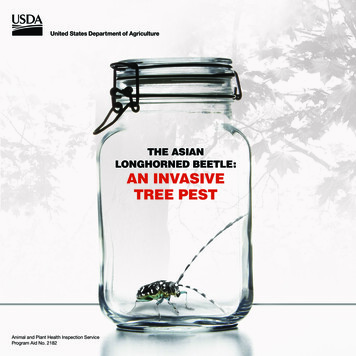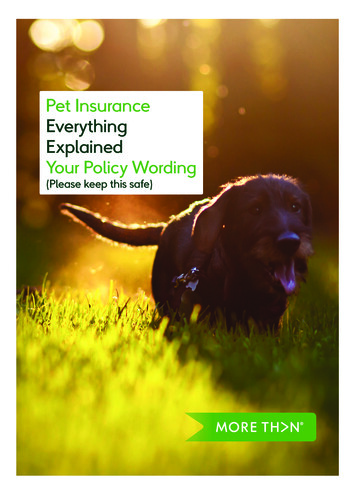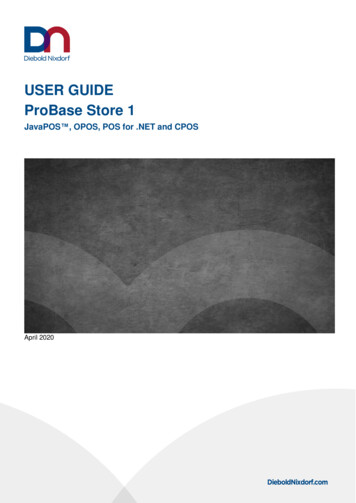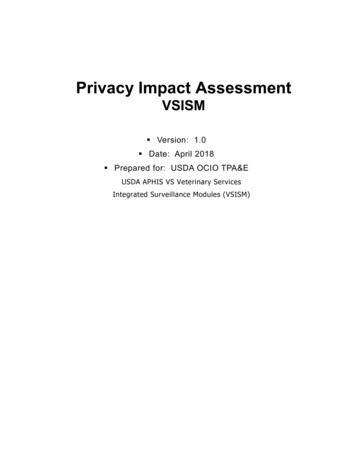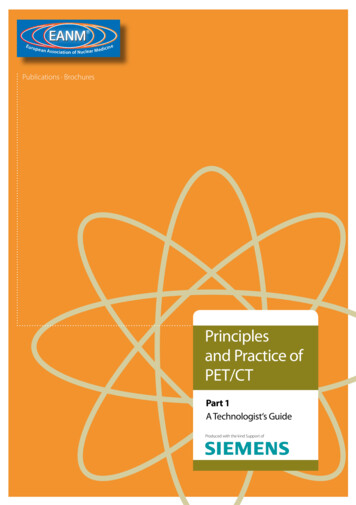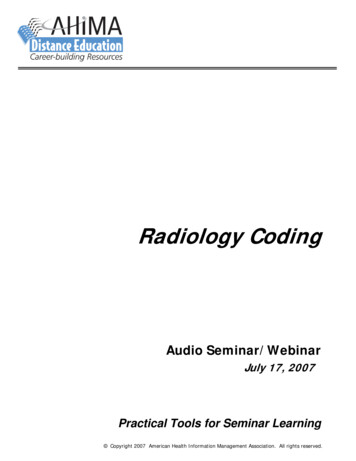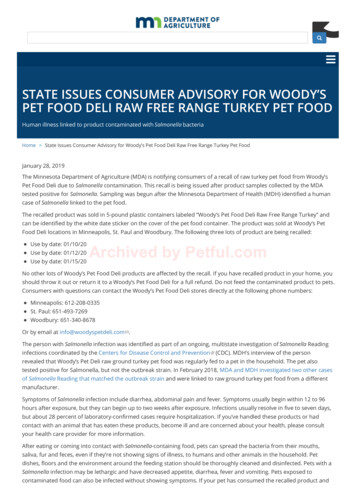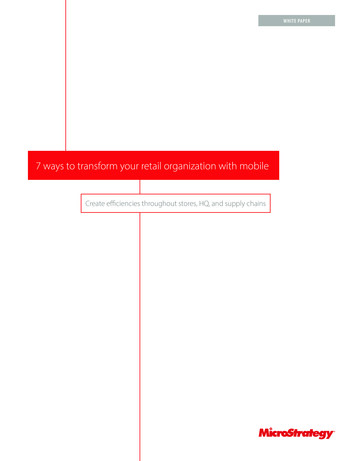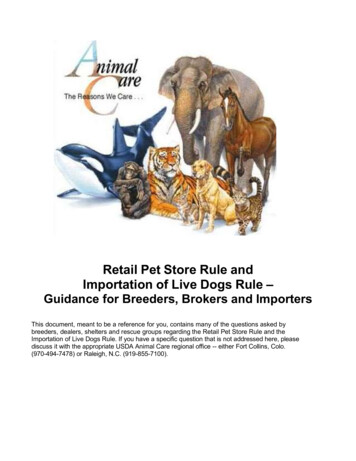
Transcription
Retail Pet Store Rule andImportation of Live Dogs Rule –Guidance for Breeders, Brokers and ImportersThis document, meant to be a reference for you, contains many of the questions asked bybreeders, dealers, shelters and rescue groups regarding the Retail Pet Store Rule and theImportation of Live Dogs Rule. If you have a specific question that is not addressed here, pleasediscuss it with the appropriate USDA Animal Care regional office -- either Fort Collins, Colo.(970-494-7478) or Raleigh, N.C. (919-855-7100).
Table of ContentsThe table of contents lists the major topic headings and related questions and answers. Click on thelinks to view the pertinent information.AbbreviationsGeneral QuestionsPage1. What is the Animal Welfare Act?1. What Is APHIS’ and what does it do?1. Why was the definition of retail pet store (RPS) changed in the regulations?2. How do these changes protect consumers better than the alternatives?2. How do Face-to Face transaction help USDA ensure humane treatment?2. What is the definition of a retail pet store?3. What specific changes were made to the AWA Regulations?3. What is the history of the development of the changes?3. Can I get a copy of the AWA and the Regulations?3. What is a wholesale transaction?4. Does APHIS regulate all wholesale transactions?4. What changes are there for retail pet stores?4. What changes are there for current USDA licensees?4. What changes are there for boarding kennels?4. How did you estimate how many people the change would affect?5. How many licensees does the USDA expect to lose by raising the de minimis standard?5. How many additional breeders will require a license under the RPS rule?5. How many comments did you receive on the proposed rule?5. How do I know if this rule covers me?5. Do I need a license if I show regulated animals?5. When did the RPS rule go into effect?Rescues, Shelters and PoundsPage6. What is the definition of a “rescue facility” and which of these are included in the changes?6. Does the rule mean rescue groups, humane societies and shelters need a license?6. Can you clarify how USDA handles groups that collect adoption fees for animals?6. How will the RPS rule affect groups that hold off-site adoption events?6. How do you inspect a group that has foster homes all over the country and only uses an individual home occasionally?6. Do volunteers that transport regulated animals to their new homes need a USDA license?ii
Breeders Who AdoptPage7. Do breeders who assist adoption groups, placing adopted animals in their new homes sight-unseen, need a USDAlicense?8. Will breeders who transport adopted animals to their new homes need a USDA registration?8. I own three breeding females and take in dogs for adoption. Can I ship an animal from one of my breeding females sightunseen that, although bred to preserve bloodlines, does not have the qualities for use in a breeding program?8. Does the sight-unseen exemption for four or fewer breeding females apply if I place adopted animals?8. I have females I breed and dogs that are owned by a non-for-profit 501(c)(3) adoption group. I sell the dogs I breed topreserve breeding stock and bloodlines. The adoption group places the dogs as pets after neutering. I do not receivecompensation for their care - although the adoption group pays for some of their care directly. If I sell my dogs face-toface, do I need a license if I have adoption dogs on my premises that the group sells sight-unseen?“Face-to-Face” vs. “Sight-Unseen” SalesPage9. If I already have a USDA AWA license, but I sell some animals sight-unseen, do I need to get another USDA license?9. Do you regulate sight-unseen sales of pets to buyers in foreign countries under the RPS rule?9. Can I sell within my state sight-unseen without a license?9. Why is it important for a buyer to observe an animal personally before taking custody?9. Do sellers who breed pets at their homes have to allow buyers in if they have a USDA license?9. Does the use of video or other electronic means to view pets for sale constitute a “face-to-face” transaction?10. Can the seller come with the animal to the buyer’s location to meet the face-to-face requirement?10. Does the RPS rule mean that no one can sell regulated animals over the Internet?10. If a person cannot personally observe an animal before buying it, can someone else stand in? If so, who can qualify to bea stand-in buyer?10. Can the seller’s veterinarian stand in for a family buying over the Internet?10. Can an employee of the seller or a volunteer represent the seller at a face-to-face sale?Importing Dogs For Resale or AdoptionPage11. There are thousands of animals imported into the United States by adoption groups for sale. This is a threat to Americanbusiness as competition in the market and animals and people from to illnesses and parasites carried by these dog. Whatis the USDA doing to regulate this activity?11. I cannot import dogs younger than 6 months for resale, but can I import dogs to use in my breeding program?11. What if I import a puppy for my breeding program and then as it matures I do not believe it should be used for breeding?May I then sell it without violating the regulations?11. Do I need a permit to import dogs if I sell or adopt dogs to new owners before they are imported?iii
Shipping AnimalsPage11. When do breeders need a license to ship animals?12. Can I sell pets face-to-face and still ship animals for exempt purposes sight-unseen?12. Did USDA consider the effect of the rule on the disabled obtaining suitable pets?12. How will USDA enforce the RPS rule?12. How will shippers, for example airlines, know if the animal is being shipped legally?12. Can a transporter deliver an animal on my behalf if I sell animals sight-unseen?13. What Is an Intermediate Handler?Exempt Sales PurposesPage13. How do you define a working dog?13. What does “breeding purposes” mean?14. Why are sales of animals sight-unseen for hunting, breeding, etc., exempt even if they have more than four breedingfemales?14. Does USDA have a specific list of purebred dogs that they consider ‘security’ dogs, therefore exempting breeders of thosedogs from licensing?14. We sell our puppies used as pets face-to-face, so that is exempt. We sell those used for hunting, security or breedingsight-unseen, so that is exempt. Is that correct?14. If I breed animals for show purposes and sell them sight-unseen, do I need a license?15. Are racing greyhounds exempt?14. If I sell my puppy/dog to a buyer for “security” purposes am I exempt from licensing?15. What animals does the 500 exemption cover?15. Why are you removing restriction on the source of gross income from the licensing exemption for people who breed certainspecies and derive no more than 500 in annual sales15. Why isn’t the 500 adjusted for inflation?15. Do you require that a dog and cat breeder make no more than 500 on a litter to be exempt and allowed to own more thanthe four-dog limit?15. Is the 500 limit just for the sale of animals or anything I may sell? We also require a deposit, this is part of the total costbut it is not the cost of the animal itself. Is this included?What Is A “Breeding Female”Page15. What is the definition of a ”breeding female?”16. Will a veterinarian determine the breeding status of a female?16. If I am a “show breeder” and have more than four breeding females, can I still ship my “show quality” puppy sight-unseenwithout a license since they technically are “breeding stock?”16. Do you count spayed females or ones that I have not bred as breeding females?16. Will you consider a retired female who has not yet been spayed, yet no longer cycles, as a breeding female? How will thisaffect a 4-6 month old female who is not yet cycling and too young to breed?16. Are visiting breeding females included in the count of breeding females in a kennel?4
What is the “4 or Fewer” Exemption?Page17. What are my premises?17. Why do you allow people with up to four breeding females to sell sight-unseen without a license under the AWA?17. How will the 4-breeding-females exemption apply to breeders with a partial ownership interest in a number of breedinganimals?17. What does “born and raised,” mean in the context of the breeding female exemption?18. Many breeders purchase animals for breeding from other breeders or get a puppy in lieu of a stud fee. When the animalsretire animals, they sell them as pets. With the sale as a pet of a retired animal that was obtained from another breederchange the licensing requirements?18. Does an occasional sale of a dog not born and raised on my premises require a license?18. How does this apply to handlers who breed?18. If I have four breeding female dogs, and my daughter raises show rabbits do her numbers count against mine if they arehoused on one premise?Applying for a LicensePage18. Where does the rule apply?18. Can I raise and socialize regulated animals in my home if I am licensed?19 . Can I raise regulated animals with adults other than the mother?19. Why are breeding females the standard instead of dogs in commerce?19. Why is the federal government involved?19. How can I get a license application packet?19. How quickly will covered breeders have to come into compliance?20. Where are breeder, dealer and exhibitor defined?20. Other agencies, such as states, that require licensing conduct the same kind of inspections as USDA. It seems likeduplication for you to do the same inspections. Will you offer exemptions to those engaged in regulated activities thatother agencies inspect?20. Will you work with state agencies to identify those needing licensing?20. Do I need both a state and an APHIS license?20. What do I need to do to prepare for the pre-inspection?21. What happens if I do not pass the first pre-inspection?21. If I fail the first pre-inspection, can I continue to sell animals?21. How long after I apply will the inspection occur?21. When is the annual license renewal due?21. Once an applicant is licensed, when do inspections occur?22. Do you take photos during the pre-license inspection?22. Can I withdraw my application without a penalty?22. If I don’t breed each year, when do I need a license?22. What is the cost of licensing?22. What are license fees based on?22. Where can I find the fee schedule?22. What is the total cost for licensing, tags, and recordkeeping?23. What is the cost for covered breeders?23. Will it cost a lot to upgrade facilities?5
Compliance With RegulationsPage23. How will you enforce the regulations?23. What steps does USDA take when it believes it has found an unlicensed activity? What are the options – both if it needs alicense, and if it is operating within the law?24. What outreach did you do?24. How do you investigate complaints?24. How many complaints have you received?24. Is this a “one size fits all” rule?25. Can breeding females be kept in a home?25. Can an Inspector give advice about correcting problems?25. Will an Inspector issue a citation if the carpet in the room housing animals is soiled with urine and feces?USDA InspectionsPage25. What specific coordinate identification must an authorized USDA Inspector present before gaining access to theresidence?25. How will USDA verify which areas are for regulated activities?25. Will Inspectors photograph my home and its interior and make those pictures available to anyone on the Internet?26. When an Inspector arrives, will enforcement focus on the written rules or the “intent” stated in the various conference calls,commentary and FAQ?26. How do you document information on the regular inspection reports?26. What do Inspectors need to see during an inspection?26. How do you coordinate between your Inspectors and the Investigative and Enforcement Service (IES)?27. What are your standard operating procedures for bio-security?27. Can Inspectors come to my house if I am not home to conduct a regular inspection or responding to a complaint?27. How can small breeders be licensed and comply with unannounced inspections when most have jobs outside the home?27. How often do inspections usually take place?28. Is there a logo that can be placed on a website to show that facility complies with the USDA and AWA regulations?28. What is the appeals process if a situation comes up during the inspection or if I disagree with the report?InspectorsPage28. What specific identification must an authorized USDA Inspector present before gaining access to the residence?28. What does the ID look like?28. Can we verify the Inspector’s ID?29. Who do you permit to accompany an Inspector?29. Are members of the ASPCA or a humane society ever part of an inspection team?29. How will this change the Inspector’s workload?29. Will I get the same Inspector all the time?29. Is there a different Inspector for each species?29. What background do Inspectors have and what training do they receive?6
Availability of Inspection InformationPage30. How can the public monitor licensees?30. Are inspection reports available on-line?30. Since the Inspection report lists number of animals, can this information to be used against the licensees by outsideorganizations? What is included in a report under the Freedom of Information Act (FOIA)?30 Do you share the information on USDA licensed pet dealers with local governments that have dealer-regulating agencies?What is the Effect on Other Species?Page30. Birds31. Cold-Blooded species31. Farm animals used for food, fur or fiber31. Rabbits raised for food, fur or fiber31. Farm animals for other uses31. Internet sales of small pocket pets31. Sales of rabbits as pets31. Does this affect 4-H projects?31. Rodents (Rats and Mice)Contact InformationPage32. Where can we contact Animal Care?32. How can I request an application packet?32. What is the best number for additional information?AbbreviationsAPHISAnimal and Plant Health Inspection ServiceAWAAnimal Welfare ActAWOAnimal Welfare OperationsIESInvestigative and Enforcement ServiceIRImport RuleOIGOffice of the Inspector GeneralRPSRetail Pet StoreUSDAUnited States Department of Agriculturevii
General QuestionsQuestion. What is the Animal Welfare Act?Answer. The Animal Welfare Act (AWA) (7 U.S.C. §§2131-2159), originally passed by Congress in 1966, setsgeneral standards for humane care and treatment required for certain animals sold at wholesale or through abroker, publicly exhibited, used in biomedical research, or commercially transported. The AWA does not apply tocoldblooded animals or to farm animals used or exhibited for agricultural purposes. People licensed under theAWA must comply with its standards for housing, sanitation, nutrition, water, and veterinary care for their animals.They must also protect their animals from extreme weather and temperatures. Congress gave the Unites StatesDepartment of Agriculture (USDA) the authority to administer the AWA and issue regulations under it. It isimportant to note, however, that USDA only has authority over animal abuse by those who USDA regulates orrequire regulation under the AWA. The laws in the individual states control all other animal abuse.Question. What is APHIS and what does it do?Answer. USDA consists of several agencies. The Animal and Plant Health Inspection Service (APHIS) is part ofthe USDA and has a number of program units. One of its programs is Animal Care (AC), which protects andpromotes animal welfare and administers the AWA and the Horse Protection Act (HPA).The AWA requires humane care and transportation of certain animals used for biomedical research, teaching,testing, or experimentation; used for exhibition, such as in circuses or zoos; or sold by breeders or other dealersfor use as pets, for research or for exhibition. AC has four main offices. The headquarters office is in Riverdale,Maryland; the Center for Animal Welfare is in Kansas City, Missouri; and the two Animal Welfare Operations(AWO) Offices are in Raleigh, North Carolina; and Fort Collins, Colorado. Inspectors are located throughout thecountry.The Mississippi River serves as the major boundary. If you live east of the Mississippi River, please contact theAWO Office in Raleigh, NC. If you live West of the Mississippi (with the exception of Minnesota), please contactthe AWO Office in Ft Collins, CO. The Raleigh Office supervises facilities in the state of Minnesota.USDA employs more than 120 Inspectors nationwide to enforce the AWA and HPA. They are experts on animalcare and husbandry, with formal training and a background in animal-related fields, such as veterinary medicine,animal science, and biology. They have extensive experience and training on the inspection of all types offacilities, such as zoos and kennels. They are trained to recognize pain and suffering in animals and are keptinformed of new information related to animal welfare and health. Experts continually evaluate our Inspectors toensure that inspections are fair, consistent and accurate.In addition to Inspectors, Animal Care also employs experts on the care and handling of dogs and cats in kennels,birds, elephants, marine mammals, large exotic cats, and nonhuman primates.Back to the Table of ContentsQuestion. Why was the definition of a retail pet store (RPS) changed in the regulations?Answer. APHIS wrote the previous regulatory definition of a RPS more than 40 years ago. It included traditionalpet stores, hobby breeders, and other retail businesses where customers could personally observe an animal forsale prior to purchasing and/or taking custody of it. USDA did not regulate such establishments under the AWAbecause it considered the ability of customers to view animals before purchasing or taking custody of themprovided sufficient oversight of their welfare. At that time, large-scale, commercial breeders primarily sold directlyto pet stores at wholesale.1
With the increasing use of the Internet as a marketing and sales tool, some commercial breeders began sellingsight-unseen at retail without public oversight. Over the years, USDA received an increasing number of publiccomplaints about the lack of monitoring and oversight of the health and humane treatment of dogs and other petssold sight-unseen — often over the Internet.The Office of the Inspector General (OIG) conducted an audit in 2010 that found that more than 80 percent ofsampled large breeders avoided licensing under the AWA because they claimed RPS status, but sold pets sightunseen. The OIG found that some buyers received unhealthy pets, especially dogs, since there was nomonitoring or inspection to ensure their animals’ overall health and humane treatment. The OIG recommendedthat such operations should not enjoy RPS status if there were no consumer oversight and should be subject toUSDA inspections.The primary goal of the regulation is to ensure that USDA monitors and regulates pets sold at retail sight-unseenfor health and humane treatment under the AWA. To do that, APHIS revised the regulatory definition of RPS toregulated and inspect animals involved in sight-unseen transactions under the AWA.Question. How do these changes protect consumers any better than being state licensed, inspected, and havinga health certificate by a licensed veterinarian to travel?Answer. This rule focuses on the welfare of the animal. It is not a consumer protection law. However, improvingthe health and welfare of pet animals does provide a benefit for the purchaser.Question. How do face-to-face transactions help USDA ensure humane treatment?Answer. By personally observing the animal, the buyer provides public oversight over the animal and helps toensure the animal’s health and humane treatment. Members of the public can notify local law enforcement orUSDA if they observe dogs subject to inhumane treatment. Our primary goal is to ensure that we monitor petssold to the public, at retail, sight-unseen for health care and humane treatment. The definition of RPS nowrequires that these animals receive the basic standards of care.Back to the Table of ContentsQuestion. What is the definition of a retail pet store?Answer. A RPS is a place of business or residence at which the seller, buyer, and the animal available for retailsale are physically present so that the buyer may observe the animal in person before purchasing and/or takingcustody of it. Only the following animals for sale or offered for sale are included: dogs, cats, rabbits, guinea pigs,hamsters, gerbils, rats, mice, gophers, chinchillas, domestic ferrets, domestic farm animals, birds, andcoldblooded species. It is important to note, however, that USDA does not regulate coldblooded species ordomestic farm animals used for food and fiber. Retailers who sell their pet animals to customers in face-to-face transactions do not need a USDA licensebecause the animals are subject to public oversight, which helps ensure their health and humane treatment. The number of breeding females you have on your premises is not relevant if you sell all your pet animals inface-to-face transactions. A facility that has a combination of four or fewer breeding female dogs, cats and or small exotic or wildmammals, is not subject to the USDA regulation as long as all of the animals offered for retail sale (for pets orexhibition) were born and raised on the seller’s premises.2
Anyone who sells or negotiate the sale or purchase of any animal, except wild or exotic animals, dogs or cats,and who derives no more than 500 gross income from the sale of such animals (for example, rabbits) isexempt from regulation. The 2014 amendments to the AWA removed this from the statute, but the Secretaryhas the discretion to exempt de minimis activities from licensing. Therefore, the regulations are still in effect.APHIS is working to specify de minimis exemptions. It will provide information in the Federal Register whenthe review is complete. Groups that participate in face-to-face transactions, such as off-site adoptions, are subject to public oversight.Therefore, they do not need a license for those transactions. However, they will need a license if they haveany pet animal transactions that are not face-to-face or are wholesale for which they receive compensation ofany kind. The activity conducted is what determines whether the USDA will regulate a facility, not the for-profitor nonprofit tax status of the enterprise.Question. What specific changes were made to the AWA Regulations?Answer. The AWA regulations had the following changes: To qualify for the RPS exemption, all sales of animals for use as pet, such as dogs, cats, rabbits, guinea pigs,hamsters, gophers, chinchillas, and domestic ferrets, must be face-to-face. The buyer, seller, and animal mustbe in the same place at the same time before the purchase and/or transfer of the animal. Shipping even one animal to a buyer sight-unseen can disqualify the seller from the RPS exemption. The former direct retail sales exemption in section 2.1(a)(3)(vii) for domestic pet animals was removed fromthe regulations. The exemption for having only three breeding females (dog, cat, and small exotic/wild pocket pet) increased tofour breeding females. The 500 exemption in 2.1(a)(3)(ii) for sales of animals other than dogs, cats, and wild/exotic animals stillapplies. However, an amendment to the AWA gives the Secretary the discretion to exempt de minimisactivities from licensing. APHIS is in the process of developing those exemptions. It will provide information inthe Federal Register when the review is complete.Question. What is the history of the development of the changes?Answer. The regulation and its history are located at regsQuestion. Can I get a copy of the Animal Welfare Act and the Regulations?Answer. The AWA and current regulations [Blue Book] are available on the Internet athttps://www.aphis.usda.gov/animal welfare/downloads/AC BlueBook AWA FINAL 2017 508comp.pdfThe AWO offices maintain a limited supply of hard copies to minimize our environmental impact and toprovide them to those that cannot access the electronic version.Back to the Table of ContentsQuestion. What is a wholesale transaction?Answer. A wholesale transaction is the transfer of a regulated animal for compensation to a person or businessthat resells that animal to the end consumer. For example, a sale to a Dealer or to a RPS is a wholesaletransaction because the purchaser is selling the animal again to the end consumer. The sale of regulated3
animals at auction is also wholesale activity.Question. Does USDA regulate all wholesale transactions?Answer. Anyone who has four or fewer breeding females and only sells animals born and raised on his or herpremises may sell at wholesale without a license. However, anyone with five or more breeding females or sellingregulated animals not born and raised on their premises at wholesale needs a license as a Dealer.Question. What changes are there for retail pet stores?Answer. The regulatory change does not affect a traditional RPS that sells regulated animals in face-to-facetransactions. Most “brick and mortar” stores will continue to be exempt from Federal regulation under the AWAjust as they have been. If they sell animals sight unseen, they will require either a class A license if they sell onlydogs born and bred on their premises or a class B license if they sell dogs obtained from others.Question. What changes are there for current USDA licensees. Is there anything additional that they need to dounder the RPS revision?Answer. No. If you were already USDA licensed, you would just need to continue to meet or exceed all of theAWA requirements.Question. What changes are there for boarding kennels?Answer. No. Typical or traditional boarding facilities, where people board privately owned animals while theowners are away, are exempt from regulation under the AWA. However, if they take in animals in conjunctionwith their transport, they must register as an Intermediate Handler.Back to the Table of ContentsQuestion. How did you estimate how many people the change would affect? Can you give the breakdown byspecies?Answer. This represents breeders we identified through online breeder registries and those additional dogbreeders not included in those registries that sell and ship dogs sight-unseen. This does not include breederswho are exempt from regulation under the rule because they do not sell pets, because they do not have morethan four breeding females, or because they sell pets face-to-face.Since a very small percentage of cats in the United States are purebred and raised by breeders — and evenfewer appear breeders sell over the Internet sight-unseen — we assumed the number of affected cat breederswould be a small portion of those we identified.It is uncommon for rabbit breeders to sell offspring as pets or sight-unseen. Generally, breeders sell rabbits faceto-face at auctions, exhibits, and fairs where buyers are physically present. The rule also affects some currentlylicensed wholesale breeders.Most shelters and rescue groups sell or adopt regulated animals in face-to-face transactions. Those who conductsight-unseen sales or adoptions or sell at wholesale need a license.4
Question. How many current licensees does USDA expect to lose with the raising of the de minimis standard?Answer. Expanding the licensing exemption from three to four breeding females could reduce the number ofwholesale licensees. The number of current licensees that fall below the exemption threshold will be very small.Question. How many additional breeders will require a license under the RPS rule?Answer. We originally estimated that the rule would affect between 2,600 and 4,640 dog breeders, about 325 catbreeders, and no more than 75 rabbit breeders.Based on input from commenters, we were able to revise and strengthen our analysis of the number of breedersthat would come under regulation and the likely financial impacts. Compared with our earlier analysis, we expectmore regulated breeders and others transferring regulated pets will require licensing and inspection. The costsshould be relatively low for most, probably only for recordkeeping, licensing, and identification tags.Further analysis based on FY2013 data showed that raising the “de minimis” level from three to four breedingfemales affected a much smaller number of Class A license holders. More than 90 percent of the Class A dogbreeders had well over five breeding females in this period.Question. How many comments did you receive on the proposed rule?Answer. USDA published the proposal on May 16, 2012, and extended the comment period from 60 to 90 daysat the request of stakeholders. The comments period closed on August 15, 2012. We received more than210,000 comments for the proposed rule: There were 75,584 individual comments, 134,420 signed form lettersand 213,000 signatures on petitions submitted by organizations supporting or opposing the proposed rule. Wereviewed every comment and made a number of changes to the final rule based on stakeholder feedback.Question. How do I know if this rule covers me?Answer. Reach out to us. Let’s talk. By discussing how you operate and how you sell or place your animals, wecan make a determination whether you may need to a license from USDA or you may decide to change yourmethod of sale or placement so that you do not require licensing.Question. Do I need a license if I show regulated animals?Answer. No. You do not need a license to show your animals. The AWA and its regulations apply to the sale ofdogs in commerce, their use in research and entertainment (e.g., circuses and zoos), and other defined areas.The term exhibition does not govern participation in shows or state fairs where people show breeding stock orfarm animals in competition.Question. When did the RPS rule go into effect?Answer. USDA published the rule on September 18, 2013 and it went into effect on November 18, 2013. To getmore information, click on the link: http://tinyurl.
15. Is the 500 limit just for the sale of animals or anything I may sell? We also require a deposit, this is part of the total cost but it is not the cost of the animal itself. Is this included? What Is A "Breeding Female" Page 15. What is the definition of a "breeding female?" 16. Will a veterinarian determine the breeding status of a .
